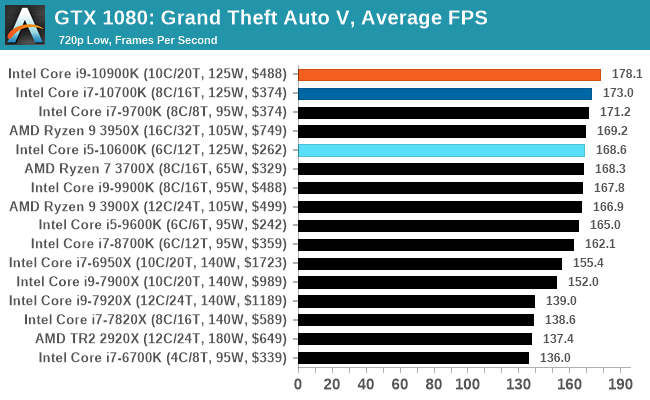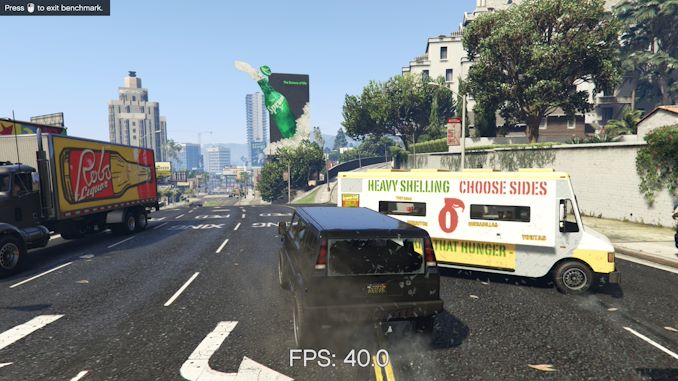The Intel Comet Lake Core i9-10900K, i7-10700K, i5-10600K CPU Review: Skylake We Go Again
by Dr. Ian Cutress on May 20, 2020 9:00 AM EST- Posted in
- CPUs
- Intel
- Skylake
- 14nm
- Z490
- 10th Gen Core
- Comet Lake
Gaming: Grand Theft Auto V
The highly anticipated iteration of the Grand Theft Auto franchise hit the shelves on April 14th 2015, with both AMD and NVIDIA in tow to help optimize the title. GTA doesn’t provide graphical presets, but opens up the options to users and extends the boundaries by pushing even the hardest systems to the limit using Rockstar’s Advanced Game Engine under DirectX 11. Whether the user is flying high in the mountains with long draw distances or dealing with assorted trash in the city, when cranked up to maximum it creates stunning visuals but hard work for both the CPU and the GPU.
For our test we have scripted a version of the in-game benchmark. The in-game benchmark consists of five scenarios: four short panning shots with varying lighting and weather effects, and a fifth action sequence that lasts around 90 seconds. We use only the final part of the benchmark, which combines a flight scene in a jet followed by an inner city drive-by through several intersections followed by ramming a tanker that explodes, causing other cars to explode as well. This is a mix of distance rendering followed by a detailed near-rendering action sequence, and the title thankfully spits out frame time data.
There are no presets for the graphics options on GTA, allowing the user to adjust options such as population density and distance scaling on sliders, but others such as texture/shadow/shader/water quality from Low to Very High. Other options include MSAA, soft shadows, post effects, shadow resolution and extended draw distance options. There is a handy option at the top which shows how much video memory the options are expected to consume, with obvious repercussions if a user requests more video memory than is present on the card (although there’s no obvious indication if you have a low end GPU with lots of GPU memory, like an R7 240 4GB).
All of our benchmark results can also be found in our benchmark engine, Bench.

| AnandTech | IGP | Low |
| Average FPS |  |
 |
| 95th Percentile |  |
 |











220 Comments
View All Comments
Darkworld - Wednesday, May 20, 2020 - link
10500k?Chaitanya - Wednesday, May 20, 2020 - link
Pointless given R5 3000 family of CPUs.yeeeeman - Wednesday, May 20, 2020 - link
Yeah right. Except it will beat basically all and lineup in games. Otherwise it is pointless.yeeeeman - Wednesday, May 20, 2020 - link
All AMD lineup*SKiT_R31 - Wednesday, May 20, 2020 - link
Yeah with a 2080 Ti the flagship 10 series CPU beats AMD in most titles, generally by a single digit margin. Who is pairing a mid-low end CPU with such a GPU? Also if there were to be a 10500K, you probably don't need to look much further than the 9600K in the charts above.This may have been missed on you, but what CPU reviews like the above show is: unless you are running the most top end flagship GPU and are low resolution high fps gaming, AMD is better at every single price point. Just accept it, and move on.
Drkrieger01 - Wednesday, May 20, 2020 - link
It also means that if you have purchased an Intel 6th gen CPU in i5 or i7, there's not much reason to upgrade unless you need more threads. And it will only be faster if you're using those said threads effectively. I'm still running an i5 6600K, granted it's running at 4.6GHz - there's no reason for me to upgrade until either Intel and/or AMD come up with better architecture and frequency combination (IPC + clock speed).I'll likely be taking the jump back to AMD for the Ryzen 4000's after a long run since the Sandy Bridge era.
Anyone needing only 4-6 cores should wait until then as well.
Samus - Thursday, May 21, 2020 - link
That's most people, including me. I'm still riding my Haswell 4C/8T because for my applications the only thing more cores will get me is faster unraring of my porn.Lord of the Bored - Thursday, May 21, 2020 - link
Hey, that's an important task!Hxx - Wednesday, May 20, 2020 - link
at 1440p intel still leads in gaming. It may not lead by much or may not lead by enough to warranty buying it over Intel but the person buying this chip is rocking a high end gpu and will likely upgrade to a high end gpu and the performance gap will only widen in intel's favor as the gpu becomes less of a bottleneck. So yeah pairing this with a 2060 makes no sense, go AMD. but pairing this with a 2080ti and a soon to be released 3080TI oh yeah this lineup will be a better choice.DrKlahn - Thursday, May 21, 2020 - link
By that logic the new games released since the Ryzen 3x000 series debut last year should show a larger gap at 1440+ between Intel and AMD. But they don't. And judging by past trends I doubt they will in the future either.As GPUs advance so does the eye candy in the newer engines, keeping the bottleneck pretty much where it always is at higher resolutions and detail levels, the GPU.